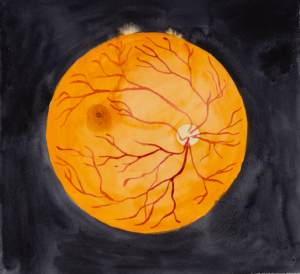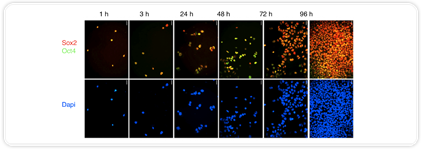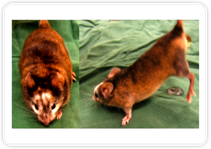Biolaminin 511 LN (LN511)
Full-length human recombinant laminin-511
Biolaminin 511 is the natural laminin for mouse embryonic stem cells. This full-length laminin-511 protein supports sustained pluripotency without the need for differentiation inhibitors, such as LIF. It also efficiently promotes the differentiation of many tissue-specific human cell types.

Biorelevant microenvironment keeps mouse stem cells pluripotent for months
Biolaminin 511 is a full-length human recombinant laminin used as a mouse ESC or iPSC culture substrate. Laminin-511 supports stem cell renewal in a reproducible manner.
Laminin-511, together with laminin-521, are the most widely expressed laminins in the body. Stem cells grow as monolayers on LN511 enabling equal contact to both the matrix and cell culture medium, which leads to a more homogenous cell population. Since Biolaminin 511 is a recombinant protein, batch-to-batch variation is minimal, and therefore fewer replicates are needed for reliable results (Domogatskaya, 2008; Rodin, 2010).
Biolaminin 511 is especially recommended for the cell culture of murine embryonic and induced pluripotent stem cells, while Biolaminin 521 is recommended for the culture of human stem cells.
Learn more about full-length laminins:
Biolaminin 511 supports human epithelial cell culture
Laminin-511 is an important regulator of hair development and an adhesion molecule for human epidermal keratinocytes supporting cell survival and growth (Yap, 2019). Laminin 511 is one of the laminins present in Bruch’s membrane located beneath the retinal pigment epithelium in the eye. Full-length laminin 511 has been shown to allow ex vivo expansion of human limbal epithelial cells of the cornea (Shibata, 2018). Precoating with Biolaminin 511 also promotes the functional recovery of transplanted corneal endothelial cells (CECs) (Zhao, 2020).
Biolaminin 511 allows robust and easy long-term expansion of primary adult human dermal keratinocytes in a defined and animal-origin free manner (Tjin, 2018). Organotypic culture shows that human keratinocytes cultured on Biolaminin 511 can form a normal stratified epidermal structure in vitro, forming a normal epidermal skin layer (Tjin 2020, Tjin 2018).
Recommended applications
-

Stem cells of animal origin
Biorelevant culture of animal stem cells on Biolaminin substrates The laminin protein family is highly conserved Laminins are a large family of […]View application -

Skin cells
Biorelevant culture of keratinocytes on Biolaminin substrates The basement membrane composition in the epidermis Human epidermal keratinocyte (HEK) cells are […]View application -

Hair follicle cells
Biorelevant culture of hair follicle stem cells on Biolaminin substrates Epithelial tissues contain a-5 and a-3 laminin isoforms Epithelial tissues are […]View application -

Intestinal cells
Biorelevant culture of intestinal cells on Biolaminin substrates Laminin expression in the intestine The small intestine contains mucosal epithelial invaginations called […]View application -

Mammary gland cells
Biorelevant culture of human mammary cells on Biolaminin substrates Laminins have both overlapping and unique functions in the mammary gland tissue Mammary […]View application -

Eye cells
Biorelevant culture of eye cells on full-length laminin-521 Laminin proteins are integral components in the eye microenvironment Biolaminin products have […]View application
Key features
Improved culture environment
Biolaminin 511 allows the proliferation of pluripotent mouse ES cells in a monolayer without differentiation inhibitors or feeder cells. The defined and biologically relevant LN511 matrix provides better opportunities for designing experiments and interpreting obtained results.
LN511 and other full-length laminins can be applied to glass for e.g. improved imaging or consistent MEA measurements, and incorporated in several other materials including hydrogels for biofunctionalization.
mESC expansion without LIF

LN511 support the self-renewal of mouse ES cells for over 5 months without the presence of LIF or feeder cells, when other known matrices are unable to do so for longer than a couple of weeks.
Homogenous monolayer

Mouse ES cells adhere to LN511 with three to five-fold higher affinity than to other commonly used matrices. Pluripotent mouse ES cells grow even at low cell density as monolayers on the surface of LN511, which is different from the conventional clusters in the cultures, and, therefore, have equal contact with the matrix and medium, allowing a homogeneous and defined growth environment.
Long-term pluripotent mouse ES cells

Mouse ES cells grown on LN511 for over 3 months are indeed pluripotent since they give rise to germline transmission (chimeric mice) after injection into mouse blastocysts.
Coating plates
1. Thaw recombinant laminins slowly at +4°C before use.
2. Dilute the thawed laminin stock solution with 1x DPBS.
3. Add the diluted laminin solution to tissue culture-treated surfaces, aiming for a final coating concentration of 0.5-2 µg/cm². The optimal coating concentration may vary depending on the specific cell line.
4. Seal the plate (e.g., with Parafilm®) to prevent evaporation, and incubate at +2°C to +8°C overnight. For faster coating, incubate at +37°C for 2 hours. Ensure the laminin solution is evenly distributed across the surface. Note that the laminin matrix will become inactivated if allowed to dry.
Important notes
Preparation and handling
- Perform all procedures under sterile conditions using aseptic techniques.
- Minimize exposure of the protein to ambient temperatures.
Storage and stability
Laminin stock solution storage
- Store the frozen laminin stock solution at -20°C to -80°C for long-term stability. Refer to the product-specific Certificate of Analysis (CoA) for detailed shelf-life information.
- Avoid repeated freeze-thaw cycles.
- For long-term storage of thawed stock solution, dispense into working aliquots and store at -30°C to -80°C. Thawed, undiluted Biolaminin stock remains stable for 3 months at +2°C to +8°C.
Coated plate storage
- Store coated plates aseptically at +2°C to +8°C for up to 4 weeks. Do not let the surface dry.
Cell culture setup
- Use appropriate culture media and dissociation reagents to create fully defined, animal component-free protocols.
- Ensure high-quality cells when transferring to the Biolaminin matrix.
- When moving your cells from another feeder-free matrix (e.g., Matrigel), we recommend starting with a smaller well format (e.g., 96-well or 48-well format) and a higher seeding density for the first few passages. This allows the cells to adapt to the laminin matrix before increasing the culture well format and lowering the seeding density.
Troubleshooting Guide
Biolaminin plate coating
Uneven cell spread is often a coating issue and may be caused by:
- Low coating concentration: Ensure the laminin coating concentration is high enough to support even cell growth. Increase the concentration if necessary.
- Poor coating coverage or plate drying: Confirm that the entire surface is covered with the laminin coating solution when preparing fresh plates. Avoid drying out the plate, as this will inactivate the laminin. Prolonged time in the incubator or long storage without proper sealing can cause evaporation, leading to localized drying, often in the center of the plate.
Product name
Biolaminin 511 LN
Product code
LN511-0202
LN511-0502
Declaration
For research use only
Storage
-20°C to -80°C
Concentration
0.1 mg/ml
Appearance
Clear, colorless, buffered solution with a pH of 7.2 with 10% glycerol and 0.02% NaN3
Shipping condition
Dry Ice
Protein name
Laminin 511 (Laminin-10)
Classification
Animal origin-free, human recombinant protein
Product application
Cell culture of murine embryonic and induced pluripotent stem cells
Laminin-511 but not -332, -111, or -411 enables mouse embryonic stem cell self-renewal in vitro
Domogatskaya A, Rodin S, Boutaud A, Tryggvason K.
Stem Cells, 2008
Long-term self-renewal of human pluripotent stem cells on human recombinant laminin-511
Rodin S, domogatskaya A, Ström S, Hansson EM, Chien KR, Inzunza J, Hovatta O, Tryggvason K.
Nature Biotechnology, 2010
Compositional and structural requirements for laminin and basement membranes during mouse embryo implantation and gastrulation
Miner JH, Li C, Mudd JL, Go G, Sutherland AE.
Development, 2004
Trophoblast-specific expression and function of the integrin alpha 7 subunit in the peri-implantation mouse embryo
Klaffky E,Williams R,Yao CC, Ziober B, Kramer R, Sutherland AE.
Developmental Biology, 2001
Xeno-free culture of human pluripotent stem cells
Bergström R, Ström S, Holm F, Feki A, Hovatta O
Methods Mol Biol, 2011
Size guide
Not sure how much laminin you need? To make it easy, we have created a tool where you can calculate the amount needed for your experiments. Just choose culture well format and fill in the desired coating concentration to see the amount required.
Please see the coating instructions for concentration and volume guidelines.